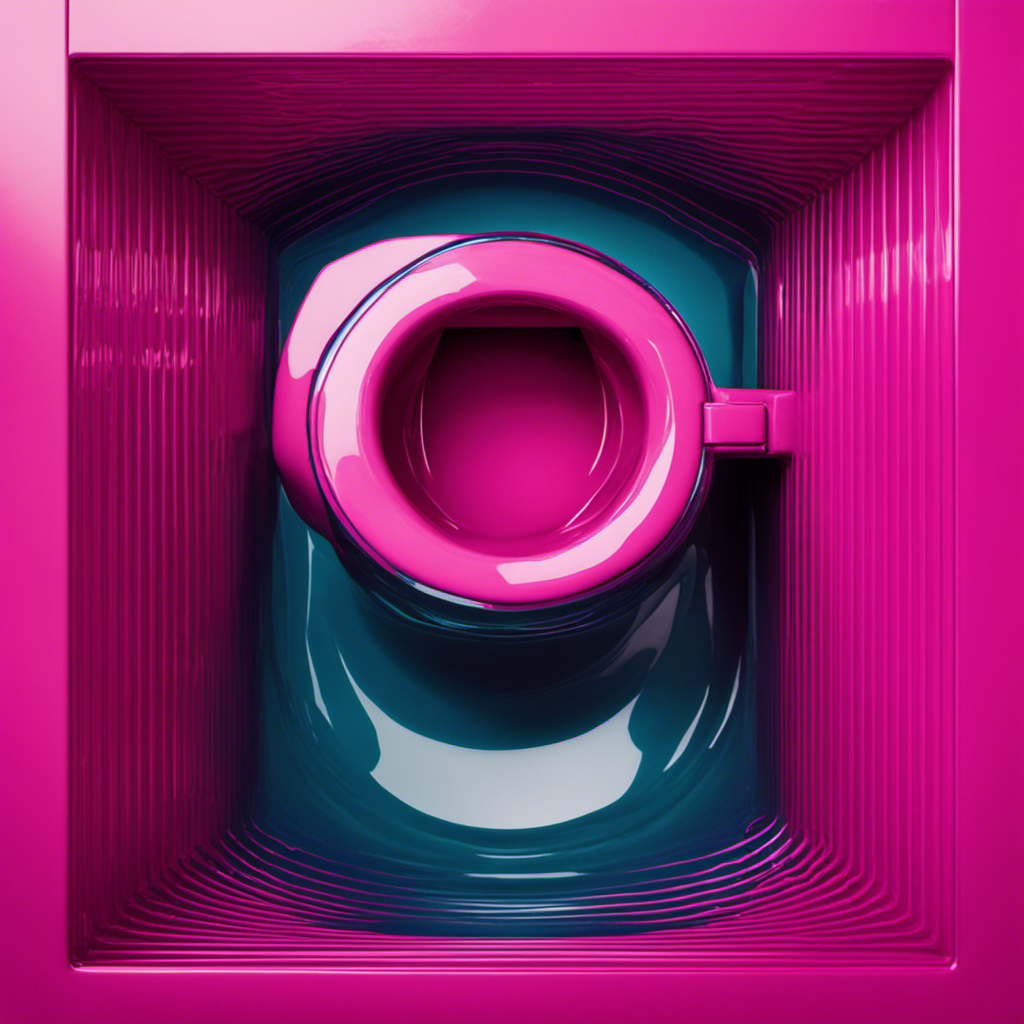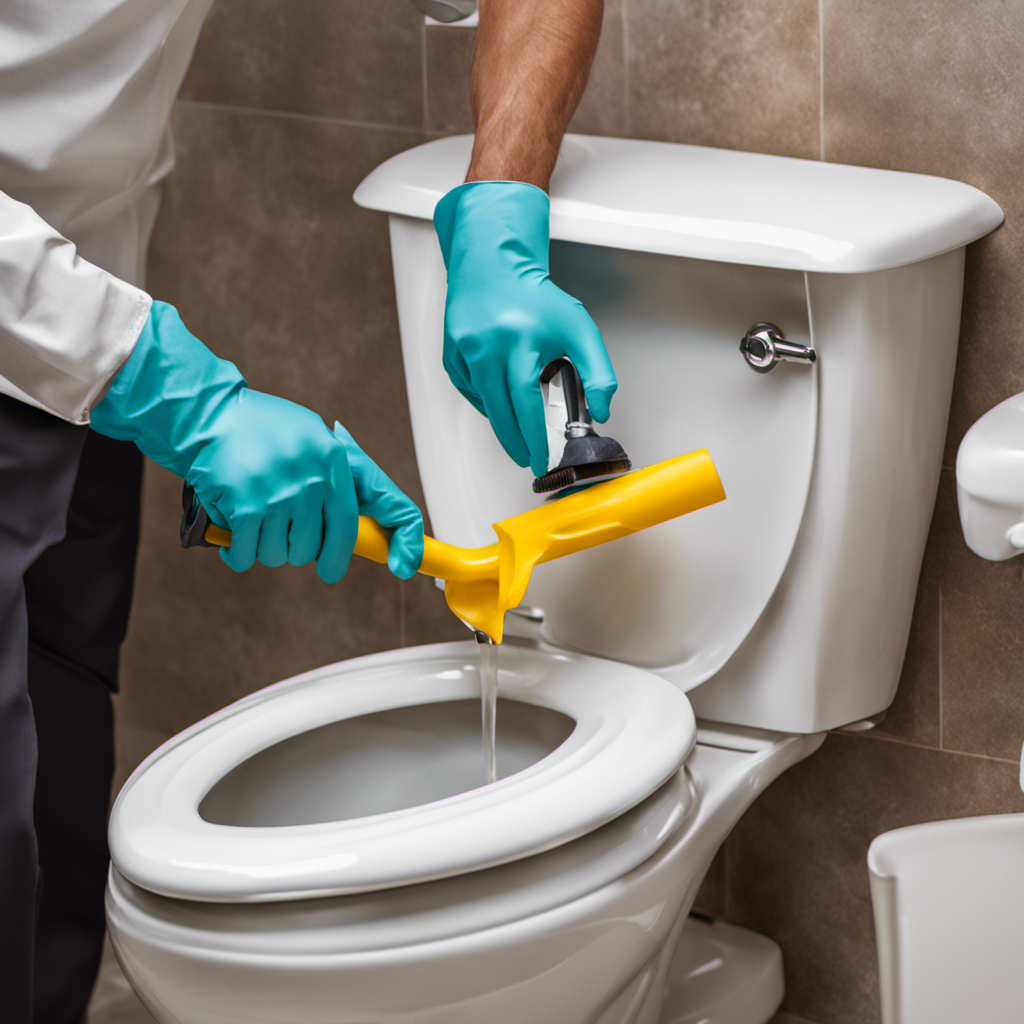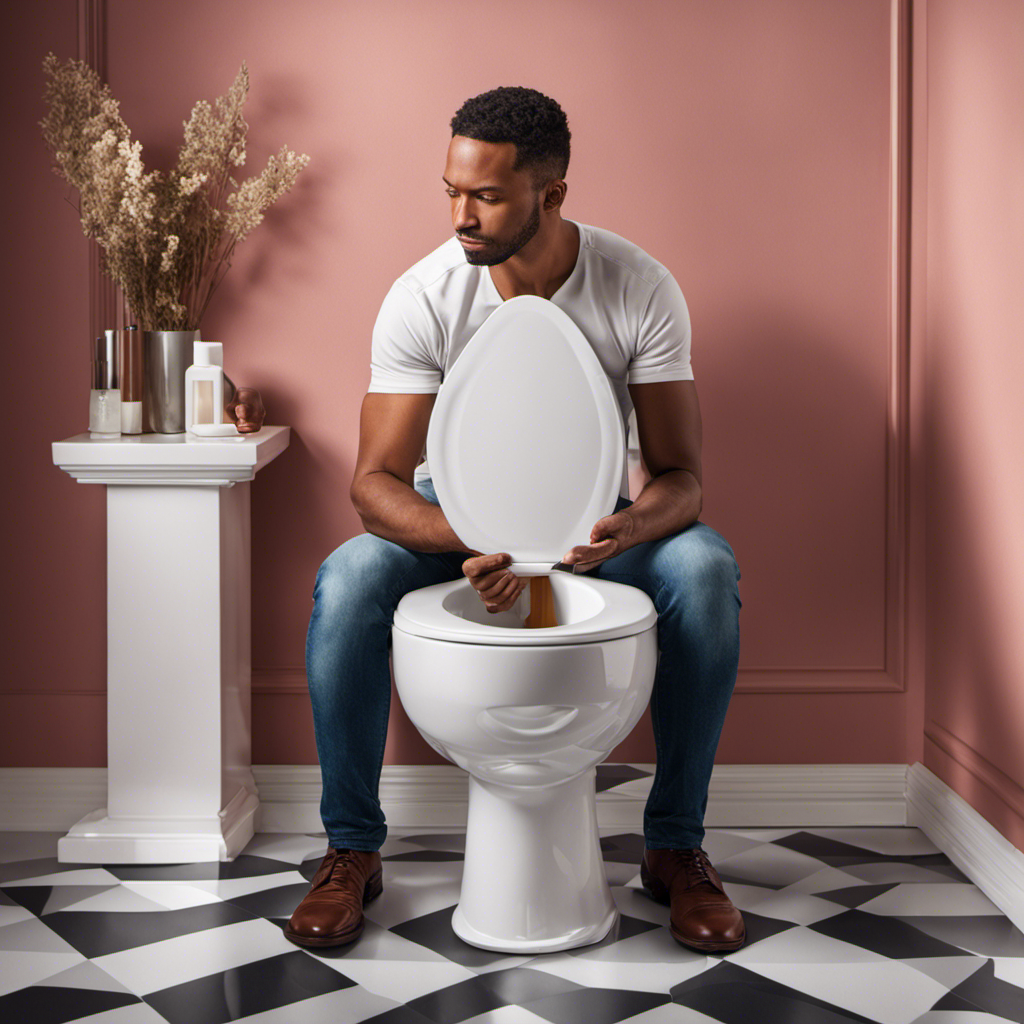So, imagine my surprise when I walked into my bathroom and discovered a pink ring in my toilet. I mean, who expects to find a pink ring in their toilet, right?
But as I delved into the science behind it, I realized there was more to this phenomenon than meets the eye. In this article, we’ll explore the common causes of pink rings, how to prevent and remove them, and the potential health risks associated with these pesky intruders.
Let’s dive in and get to the bottom of this colorful conundrum.
Key Takeaways
- Pink rings in toilets are caused by the presence of bacteria known as Serratia marcescens.
- The bacteria thrive in moist environments like toilets and produce a pigment that gives the pink color.
- Contaminated water, fecal matter, or cleaning products can introduce the bacteria to the toilet.
- Regular cleaning and maintenance, along with natural remedies like vinegar and baking soda, can prevent and remove pink rings in toilets.
The Science Behind the Pink Ring
You might be wondering why there’s a pink ring in your toilet. Well, let me explain the science behind it.
The pink ring is actually caused by the presence of certain microorganisms, specifically bacteria. These bacteria are known as Serratia marcescens and they thrive in moist environments like toilets. The pink coloration is a result of a pigment produced by these bacteria.
Now, you may be wondering how these bacteria end up in your toilet in the first place. Well, they can be introduced through various means such as contaminated water, fecal matter, or even from cleaning products. Once they find a suitable environment, they begin to multiply and form a pink ring.
Common Causes of Pink Rings in Toilets
One common cause of pink rings in toilets is the presence of bacteria. These bacteria, known as Serratia marcescens, thrive in moist environments and can multiply rapidly in the toilet bowl. Contrary to common misconceptions, the pink color is not caused by the bacteria themselves, but rather by the pigment they produce.
This pigment can stain the toilet bowl, resulting in the appearance of a pink ring. To remove these pink rings, there are several natural remedies that can be effective.
One option is to use a mixture of vinegar and baking soda. Simply pour the vinegar into the toilet bowl, followed by a sprinkle of baking soda. Let it sit for a few minutes, then scrub the bowl with a toilet brush.
Another natural remedy is to use hydrogen peroxide, which can help to break down the pigments and remove the pink stains.
How to Prevent and Remove Pink Rings
To prevent and remove those unsightly pink stains, all it takes is regular cleaning and maintenance. Here are three toilet cleaning hacks and natural remedies for pink rings:
-
Vinegar Solution: Mix equal parts white vinegar and water in a spray bottle. Spray the solution onto the pink ring and let it sit for a few minutes. Scrub the area with a toilet brush and flush. The acidity of vinegar helps break down the stains.
-
Baking Soda Paste: Create a paste by mixing baking soda with water. Apply the paste directly to the pink ring and let it sit for a few minutes. Scrub the area gently with a toilet brush and flush. Baking soda’s abrasive properties help remove the stains.
-
Citric Acid: Sprinkle citric acid powder onto the pink ring and let it sit for a while. Scrub the area with a toilet brush and flush. Citric acid is a natural cleaner that can effectively remove pink stains.
By regularly implementing these toilet cleaning hacks and natural remedies, you can prevent and eliminate pink rings in your toilet, ensuring a clean and fresh bathroom.
However, it’s important to be aware of the potential health risks associated with these pink rings.
Health Risks Associated With Pink Rings in Toilets
Regularly implementing these toilet cleaning hacks and natural remedies can help prevent and eliminate pink rings in your toilet, ensuring a clean and fresh bathroom, while being aware of the potential health risks associated with them. Pink rings in toilets are often caused by a type of bacteria called Serratia marcescens. This bacteria thrives in moist environments and can multiply rapidly, leading to the formation of pink rings. It is important to note that the presence of pink rings may indicate poor water quality, as the bacteria can thrive in water with high levels of organic matter. Ingesting or inhaling the bacteria can potentially lead to various health issues, including respiratory infections and urinary tract infections. Therefore, it is crucial to maintain good bathroom hygiene and address any pink rings promptly to minimize the risk of bacterial growth and associated health risks.
| Potential link between pink rings and bacterial growth | The impact of water quality on the formation of pink rings in toilets |
|---|---|
| Pink rings are caused by the bacteria Serratia marcescens | High levels of organic matter in water can promote bacterial growth |
| Poor bathroom hygiene can lead to the formation of pink rings | Regular cleaning and maintenance can prevent the formation of pink rings |
| Ingesting or inhaling the bacteria can cause health issues | Ensuring good water quality can help minimize the risk of pink rings |
| Promptly addressing pink rings can prevent bacterial growth | Regular water testing and treatment can help maintain water quality |
Troubleshooting Pink Rings: FAQs and Solutions
If you’re experiencing difficulty removing pink rings from your toilet, you may find the solutions to common FAQs helpful. Here are three effective ways to tackle this problem:
-
Toilet Cleaning Products: Consider using specialized toilet cleaning products that are designed to remove pink rings. Look for products that contain chemicals like hydrogen peroxide or bleach, as these can help break down and remove the pink stains effectively.
-
Natural Remedies: If you prefer a more eco-friendly approach, there are natural remedies that can help eliminate pink rings. One option is to create a paste using baking soda and water, then apply it to the affected area and scrub gently. Alternatively, you can try using white vinegar, which has natural cleaning properties. Simply pour vinegar into the toilet bowl, let it sit for a while, and then scrub away the pink stains.
-
Prevention: To prevent pink rings from forming in the first place, it’s important to regularly clean your toilet and maintain proper hygiene. Use a toilet brush and cleaner regularly to remove any buildup or residue that could contribute to the formation of pink rings.
Conclusion
After conducting research and analyzing the evidence, it is clear that the presence of a pink ring in your toilet is not just a random occurrence. The science behind it reveals that certain bacteria, such as Serratia marcescens, thrive in moist environments and can cause this discoloration.
Understanding the common causes and taking preventive measures will help you maintain a clean and healthy toilet. Remember to regularly clean and disinfect your toilet to eliminate any potential health risks associated with these pink rings.
By following the troubleshooting tips and solutions provided, you can keep your toilet pink-ring free.










